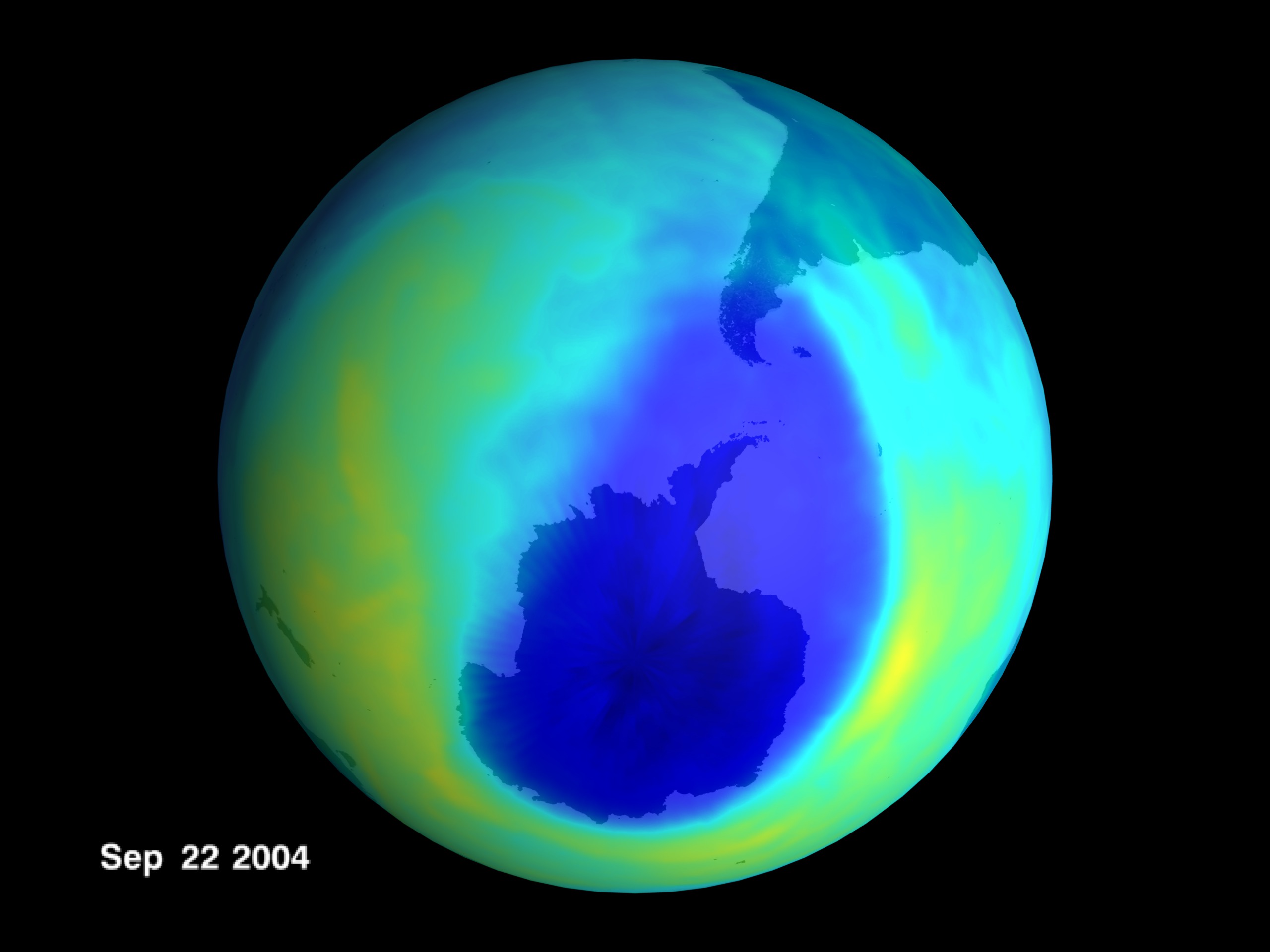Earth
ID: 3038
A relatively warm Antarctic winter in 2004 kept the thinning of the protective ozone layer over Antarctica, known as the ozone 'hole,' slightly smaller than in 2003. Each year the 'hole' expands over Antarctica, sometimes reaching populated areas of South America and exposing them to ultraviolet rays normally absorbed by ozone. Scientists have new tools to study this annual phenomenon, and the human-produced compounds that contribute to ozone breakdown are decreasing.
On September 22, 2004, ozone thinning over Antarctica reached its maximum extent for the year at 24.2 million square kilometers (9.4 million square miles). The largest maximum area on record was 29.2 million square kilometers, in 2000. On October 5, 2004, the ozone layer reached a low value of 99 Dobson Units.

The 2004 Antarctic Ozone Hole
On September 22, 2004, ozone thinning over Antarctica reached its maximum extent for the year at 24.2 million square kilometers (9.4 million square miles). The largest maximum area on record was 29.2 million square kilometers, in 2000. On October 5, 2004, the ozone layer reached a low value of 99 Dobson Units.

Visualization Credits
Please give credit for this item to:
NASA/Goddard Space Flight Center Scientific Visualization Studio
NASA/Goddard Space Flight Center Scientific Visualization Studio
Short URL to share this page:
https://svs.gsfc.nasa.gov/3038
Data Used:
Note: While we identify the data sets used in these visualizations, we do not store any further details nor the data sets themselves on our site.
Dates of Data Used:
2004/08/01 - 2004/10/19
This item is part of this series:
Ozone
Keywords:
SVS >> Antarctic
DLESE >> Atmospheric science
GCMD >> Earth Science >> Atmosphere >> Atmospheric Chemistry/Oxygen Compounds >> Ozone
SVS >> For Educators
SVS >> Greenhouse Gases
SVS >> Stratospheric Ozone >> Distribution
SVS >> Greenhouse Effect
NASA Science >> Earth
GCMD keywords can be found on the Internet with the following citation: Olsen, L.M., G. Major, K. Shein, J. Scialdone, S. Ritz, T. Stevens, M. Morahan, A. Aleman, R. Vogel, S. Leicester, H. Weir, M. Meaux, S. Grebas, C.Solomon, M. Holland, T. Northcutt, R. A. Restrepo, R. Bilodeau, 2013. NASA/Global Change Master Directory (GCMD) Earth Science Keywords. Version 8.0.0.0.0
https://svs.gsfc.nasa.gov/3038
Data Used:
Earth Probe/TOMS/Ozone
2004/08/01 - 2004/10/19Dates of Data Used:
2004/08/01 - 2004/10/19
This item is part of this series:
Ozone
Keywords:
SVS >> Antarctic
DLESE >> Atmospheric science
GCMD >> Earth Science >> Atmosphere >> Atmospheric Chemistry/Oxygen Compounds >> Ozone
SVS >> For Educators
SVS >> Greenhouse Gases
SVS >> Stratospheric Ozone >> Distribution
SVS >> Greenhouse Effect
NASA Science >> Earth
GCMD keywords can be found on the Internet with the following citation: Olsen, L.M., G. Major, K. Shein, J. Scialdone, S. Ritz, T. Stevens, M. Morahan, A. Aleman, R. Vogel, S. Leicester, H. Weir, M. Meaux, S. Grebas, C.Solomon, M. Holland, T. Northcutt, R. A. Restrepo, R. Bilodeau, 2013. NASA/Global Change Master Directory (GCMD) Earth Science Keywords. Version 8.0.0.0.0











